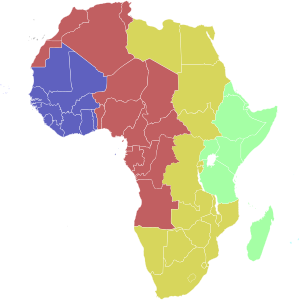
| Light Blue | Cape Verde Time (UTC−1) |
| Blue | Greenwich Mean Time (UTC) |
| Red | (UTC+1) |
| Ochre | (UTC+2) |
| Green | East Africa Time (UTC+3) |
| Turquoise | (UTC+4) |
Mauritius and the Seychelles are to the east and north-east of Madagascar respectively.
South African Standard Time (SAST) is the time zone used by all of South Africa as well as Eswatini and Lesotho. The zone is two hours ahead of UTC (UTC+02:00) and is the same as Central Africa Time. Daylight saving time is not observed in either time zone. Solar noon in this time zone occurs at 30° E in SAST, effectively making Pietermaritzburg at the correct solar noon point, with Johannesburg and Pretoria slightly west at 28° E and Durban slightly east at 31° E. Thus, most of South Africa's population experience true solar noon at approximately 12:00 daily.
The western Northern Cape and Western Cape differ, however. Everywhere on land west of 22°30′ E effectively experiences year-round daylight saving time because of its location in true UTC+01:00 but still being in South African Standard Time. Sunrise and sunset are thus relatively late in Cape Town, compared to the rest of the country.
To illustrate, daylight hours for South Africa's western and easternmost major cities:
| Summer solstice | Winter solstice | |
|---|---|---|
| Cape Town | 05:32–19:57 | 07:51–17:45 |
| Durban | 04:52–18:56 | 06:51–17:04 |
The South African National Time Standard, or 'SA Time' Master Clock, is maintained at the Time and Frequency Laboratory of the National Metrology Institute of South Africa (NMISA) at Pretoria and is distributed publicly by an NTP Internet Time service.
History
Before 8 February 1892, there was no uniformity of time in South Africa and local mean time was in use at the various towns. In 1892, a railway conference was held in Bloemfontein and discussed difficulty of working a railway system, in the absence of a uniform time system. The governments of the Orange Free State, Transvaal and the Cape Colony officially adopted a uniform standard time of UTC+01:30 which was defined as mean time 22.5° east of Greenwich. On 1 March 1903 GMT+02:00 was adopted, which became the current UTC+02:00 when UTC replaced GMT for most purposes.
Prior to 1 March 1903, the Colony of Natal was already using a uniform time supplied by the Natal Observatory. The observatory's local mean time was (UTC+01:52).
South Africa observed a daylight saving time of GMT+03:00 (UTC+03:00) between 20 September 1942 to 21 March 1943 and 19 September 1943 to 19 March 1944.
South African Standard Time is defined as "Coordinated Universal Time plus two hours" (UTC+02:00) as defined in South African National Government Gazette No. 40125 of 8 July 2016.
See also
References
- "Time & Frequency and Fibre Optics". Archived from the original on 13 February 2014. Retrieved 27 March 2014.
- "Time". Archived from the original on 9 February 2014. Retrieved 27 March 2014.
- "Timezone change of 1892". TimeAndDate.com.
- Wood, H. E. (1927–1928). "1". Official Year Book of the Union of South Africa and of Basutoland, Bechuanaland Protectorate, and Swaziland. No. 10. p. 61.
- "Timezone change of 1903".
- "Timezone change of 1925 and 1949".
- "Government Gazette No: 40125" (PDF). 8 July 2016. Archived (PDF) from the original on 28 January 2020. Retrieved 28 January 2020.
| South Africa articles | |||||||
|---|---|---|---|---|---|---|---|
| History |
| ||||||
| Geography | |||||||
| Politics | |||||||
| Economy | |||||||
| Society |
| ||||||
| Time in Africa | |
|---|---|
| Sovereign states |
|
| States with limited recognition | |
| Dependencies and other territories |
|
Categories: